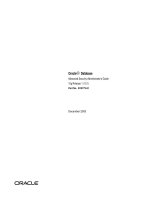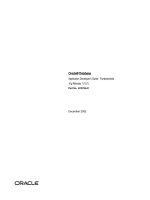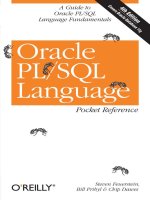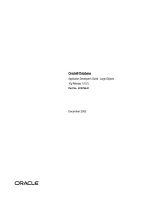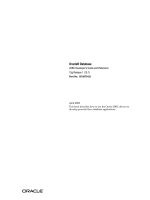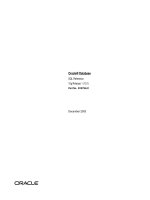Tài liệu Oracle Essentials Oracle Database 11g P docx
Bạn đang xem bản rút gọn của tài liệu. Xem và tải ngay bản đầy đủ của tài liệu tại đây (849.04 KB, 180 trang )
Oracle PL/SQL Language
Pocket Reference
FOURTH EDITION
Steven Feuerstein, Bill Pribyl,
and Chip Dawes
Beijing
•
Cambridge
•
Farnham
•
Köln
•
Paris
•
Sebastopol
•
Taipei
•
Tokyo
Oracle PL/SQL Language Pocket Reference, Fourth Edition
by Steven Feuerstein, Bill Pribyl, and Chip Dawes
Copyright © 2008 Chip Dawes, Steven Feuerstein, and Bill Pribyl.
All rights reserved.
Printed in Canada.
Published by O’Reilly Media, Inc., 1005 Gravenstein Highway North,
Sebastopol, CA 95472.
O’Reilly books may be purchased for educational, business, or sales
promotional use. Online editions are also available for most titles
(safari.oreilly.com). For more information, contact our corporate/
institutional sales department: (800) 998-9938 or
Editors:
Deborah Russell
and Mary Treseler
Production Editor:
Mary Brady
Proofreader:
Mary Brady
Indexer:
Johnna VanHoose Dinse
Cover Designer:
Karen Montgomery
Interior Designer:
David Futato
Illustrator:
Robert Romano
Printing History:
April 1999: First Edition.
February 2003: Second Edition.
April 2004: Third Edition.
October 2007: Fourth Edition.
Nutshell Handbook, the Nutshell Handbook logo, and the O’Reilly logo are
registered trademarks of O’Reilly Media, Inc. The Pocket Reference series
designations, Oracle PL/SQL Language Pocket Reference, the image of ants,
and related trade dress are trademarks of O’Reilly Media, Inc. Many of the
designations used by manufacturers and sellers to distinguish their products
are claimed as trademarks. Where those designations appear in this book,
and O’Reilly Media, Inc. was aware of a trademark claim, the designations
have been printed in caps or initial caps. Oracle® and all Oracle-based
trademarks and logos are trademarks or registered trademarks of Oracle
Corporation, Inc. in the United States and other countries. O’Reilly Media,
Inc. is independent of Oracle Corporation. Java and all Java-based
trademarks and logos are trademarks or registered trademarks of Sun
Microsystems, Inc. in the United States and other countries. O’Reilly Media,
Inc. is independent of Sun Microsystems, Inc.
While every precaution has been taken in the preparation of this book, the
publisher and authors assume no responsibility for errors or omissions, or
for damages resulting from the use of the information contained herein.
ISBN-10: 0-596-51404-2
ISBN-13: 978-0-596-51404-4
[TM]
iii
Contents
Introduction 1
Acknowledgments 1
Conventions 2
PL/SQL Language Fundamentals 2
PL/SQL Character Set 2
Identifiers 3
Boolean, Numeric, and String Literals 4
Numeric Literals 5
Datetime Interval Literals 6
Delimiters 6
Comments 8
Pragmas 8
Statements 9
Block Structure 9
Variables and Program Data 11
Scalar Datatypes 12
LOB Datatypes 18
Implicit Datatype Conversions 19
NULLs in PL/SQL 19
Declaring Variables 19
Anchored Declarations 22
Programmer-Defined Subtypes 23
iv
|
Contents
Conditional and Sequential Control 23
Conditional Control Statements 23
Sequential Control Statements 27
Loops 28
Simple Loop 29
Numeric FOR Loop 29
Cursor FOR Loop 30
WHILE Loop 30
REPEAT UNTIL Loop Emulation 31
EXIT Statement 31
CONTINUE Statement (Oracle Database 11g) 31
Loop Labels 33
Database Interaction 34
Sequences in PLSQL 34
Transaction Management 34
Autonomous Transactions 37
Cursors in PL/SQL 38
Explicit Cursors 38
Implicit Cursors 42
Dynamic Cursors 45
DBMS_SQL 46
SQL Injection and Bind Variables 47
Cursor Variables 48
Cursor Expressions 49
Exception Handling 50
Declaring Exceptions 51
Raising Exceptions 53
Scope 54
Propagation 54
Contents
|
v
Records in PL/SQL 56
Declaring Records 57
Referencing Fields of Records 58
Assigning Records 58
Records and DML 59
Nested Records 60
Collections in PL/SQL 61
Declaring a Collection 63
Initializing a Collection 64
Adding and Removing Elements 65
Nested Table Functions 65
Collection Methods 68
Collections and Privileges 71
Nested Collections 71
Bulk Binds 71
Built-in Functions and Packages 75
Built-in Functions 75
Built-in Regular Expression Functions 87
Built-in Packages 93
Stored Procedures and Functions 97
Procedures 98
Functions 99
Parameters 100
Local Programs 103
Program Overloading 104
Forward Declarations 106
Table Functions 106
Function Result Cache 107
Privileges and Stored PL/SQL 109
vi
|
Contents
Triggers 109
Creating Triggers 110
Trigger Predicates 114
DML Events 114
Compound DML Triggers 115
DDL Events 117
Database Events 117
Packages 117
Package Structure 118
Referencing Package Elements 120
Package Data 120
SERIALLY_REUSABLE Pragma 120
Package Initialization 121
Calling PL/SQL Functions in SQL 122
Calling a Function 123
Calling Packaged Functions in SQL 124
Column/Function Name Precedence 125
Object-Oriented Features 125
Object Types 126
Type Inheritance 128
Methods 128
Methods in Subtypes 132
Manipulating Objects in PL/SQL and SQL 133
Upcasting and Downcasting 135
Changing Object Types 138
Compilation 139
Compiling Stored PL/SQL Programs 140
Conditional Compilation 142
Compiler Warnings 145
Optimizing Compiler 147
Performing Native Compilation of PL/SQL 149
Contents
|
vii
Java Language Integration 152
Example 153
Publishing Java to PL/SQL 154
Data Dictionary 155
Index 157
1
Chapter 1
Oracle PL/SQL Language
Pocket Reference
Introduction
The Oracle PL/SQL Language Pocket Reference is a quick ref-
erence guide to the PL/SQL programming language, which
provides procedural extensions to the SQL relational data-
base language and a range of Oracle development tools.
Where a package, program, or function is supported only for
a particular version of the Oracle database (e.g., Oracle Data-
base 11g), we indicate this in the text.
The purpose of this pocket reference is to help PL/SQL users
find the syntax of specific language elements. It is not a self-
contained user guide; basic knowledge of the PL/SQL pro-
gramming language is assumed. For more information, see
the following O’Reilly books:
Oracle PL/SQL Programming, Fourth Edition, by Steven
Feuerstein with Bill Pribyl
Learning Oracle PL/SQL, by Bill Pribyl with Steven Feuerstein
Oracle PL/SQL Best Practices, Second Edition, by Steven
Feuerstein
Oracle in a Nutshell, by Rick Greenwald and David C.
Kreines
Acknowledgments
We are grateful to all those who helped in the preparation of
this book. In particular, thanks to Bryn Llewellyn for his
2
|
Oracle PL/SQL Language Pocket Reference
input on this latest revision as well as the third edition.
Thanks as well to first-edition reviewers Eric J. Givler and
Stephen Nelson and to second- and third-edition reviewer
Jonathan Gennick. In addition, we appreciate all the good
work by the O’Reilly crew in editing and producing this
book.
Conventions
UPPERCASE indicates PL/SQL keywords, as well as certain
identifiers used by Oracle Corporation as built-in function
and package names.
Italic indicates filenames and directories, as well as the first
use of a term.
Constant width
is used for code examples, literals, and
identifiers.
Constant width bold
indicates user input in examples show-
ing an interaction.
[]
enclose optional items in syntax descriptions.
{}
enclose a list of items in syntax descriptions; you must
choose one item from the list.
|
separates bracketed list items in syntax descriptions.
PL/SQL Language Fundamentals
This section summarizes the fundamental components of the
PL/SQL language: characters, identifiers, literals, delimiters,
use of comments and pragmas, and construction of state-
ments and blocks.
PL/SQL Character Set
The PL/SQL language is constructed from letters, digits,
symbols, and whitespace, as defined in the following table:
PL/SQL Language Fundamentals
|
3
Characters are grouped together into four lexical units: iden-
tifiers, literals, delimiters, and comments.
Identifiers
Identifiers are names for PL/SQL objects such as constants,
variables, exceptions, procedures, cursors, and reserved
words. Identifiers have the following characteristics:
• Can be up to 30 characters in length
• Cannot include whitespace (space, tab, carriage return)
• Must start with a letter
• Can include a dollar sign (
$
), an underscore (
_
), and a
pound sign (
#
)
• Are not case-sensitive
Using PL/SQL’s reserved words as identifiers in your pro-
grams is not a good idea and can result in compilation or
runtime errors that are difficult to troubleshoot.
TIP
Earlier editions of this book included a list of reserved
words. However, Oracle Database 11g Release 1 has
more than 1600 reserved words as listed in the
V$RESERVED_WORDS data dictionary view. In our
testing we determined that more than 650 of these could
not be used as procedure names or variable names. Con-
sult V$RESERVED_WORDS for the full list of unsup-
ported identifiers, and avoid using these as program or
variable names.
Type Characters
Letters
A
–
Z
,
a
–
z
Digits
0
–
9
Symbols
~!@#$%^&*( )_-+=|[ ]{ }:;"'< >,.?/ ^
Whitespace space, tab, newline, carriage return
4
|
Oracle PL/SQL Language Pocket Reference
If you enclose an identifier within double quotes, all but the
first of these rules are ignored. For example, the following
declaration is valid:
DECLARE
"1 ^abc" VARCHAR2(100);
BEGIN
IF "1 ^abc" IS NULL THEN ...
END;
Boolean, Numeric, and String Literals
Literals are specific values not represented by identifiers. For
example, TRUE, 3.14159, 6.63E-34, 'Moby Dick', and NULL
are all literals of type Boolean, number, or string. There are
no complex datatype literals as their values are internal rep-
resentations; complex types receive values through direct
assignment or via constructors. Unlike the rest of PL/SQL,
literals are case-sensitive. To embed single quotes within a
string literal, place two single quotes next to each other.
Starting with Oracle Database 10g, you can define your own
quoting mechanism for string literals in both your SQL and
PL/SQL statements. Use the characters
q'
(q followed by a
straight single quote) to designate the programmer-defined
delimiter for your string literal. Terminate the literal string
with the programmer-defined delimiter followed by a trailing
single quote—for example,
q'!my string!'
. NCHAR and
NVARCHAR delimiters are preceded by the letters
nq
,asin
nq'^nchar string^'
. This technique can simplify your code
when consecutive single quotes appear within a string, such
as the literals in a SQL statement. If you define your delimiter
with one of the four bracketing characters
([{<
, you must
use the righthand version of the bracketing character as the
closing delimiter. For example,
q'[
must be closed with
]'
.
See the following table for examples:
Literal Actual value
'That''s Entertainment!'
That’s Entertainment!
q'#That's Entertainment!#'
That’s Entertainment!
PL/SQL Language Fundamentals
|
5
Numeric Literals
You may achieve improvements in runtime performance by
making explicit the datatype of numeric literals. You can do
so by including or excluding a decimal point or by using a
trailing
f
or
d
, as shown in the following table:
Oracle Database 10g introduced several special named
constants:
BINARY_FLOAT_NAN (Not a Number)
BINARY_FLOAT_INFINITY
BINARY_FLOAT_MAX_NORMAL
BINARY_FLOAT_MIN_NORMAL
'"The Raven"'
"The Raven"
'TZ=''CDT6CST'''
TZ='CDT6CST'
q'$TZ='CDT6CST'$'
TZ='CDT6CST'
q'[TZ='CDT6CST']'
TZ='CDT6CST'
''''
'
'''hello world'''
'hello world'
q'!'hello world'!'
'hello world'
''''''
"
q'['']'
"
nq'<Price='£'>'
Price='£'
nq'-WHERE name LIKE 'ñ'-'
WHERE name LIKE 'ñ'
Literal Datatype
3.14159
NUMBER
42
INTEGER
0.0
NUMBER
3.14159f
BINARY_FLOAT
3.14159d
BINARY_DOUBLE
Literal Actual value
6
|
Oracle PL/SQL Language Pocket Reference
BINARY_FLOAT_MAX_SUBNORMAL
BINARY_FLOAT_MIN_SUBNORMAL
as well as the BINARY_DOUBLE versions of these constants.
Datetime Interval Literals
The datetime interval datatypes, introduced in Oracle9i
Database, represent a chronological interval expressed in
terms of either years and months or days, hours, minutes,
seconds, and fractional seconds. Literals of these datatypes
require the keyword INTERVAL followed by the literal and
format string(s). The interval must go from a larger field to a
smaller one, so YEAR TO MONTH is valid, but MONTH
TO YEAR is not. See the following table for examples:
Delimiters
Delimiters are symbols with special meaning, such as
:=
(assignment operator),
||
(concatenation operator), and
;
(statement delimiter). The following table lists the PL/SQL
delimiters:
Literal Actual value
INTERVAL '1-3' YEAR TO MONTH
1 year and 3 months later
INTERVAL '125-11' YEAR(3) TO
MONTH
125 years and 11 months later
INTERVAL '-18' MONTH
18 months earlier
INTERVAL '-48' HOUR
48 hours earlier
INTERVAL '7 23:15' DAY TO
MINUTE
7 days, 23 hours, 15 minutes later
INTERVAL '1 12:30:10.2' DAY
TO SECOND
1 day, 12 hours, 30 minutes,10.2seconds
later
INTERVAL '12:30:10.2' HOUR TO
SECOND
12 hours, 30 minutes, 10.2 seconds later
Delimiter Description
;
Terminator (for statements and declarations)
+
Addition operator
PL/SQL Language Fundamentals
|
7
-
Subtraction operator
*
Multiplication operator
/
Division operator
**
Exponentiation operator
||
Concatenation operator
:=
Assignment operator
=
Equality operator
<>
and
!=
Inequality operators
^=
and
~=
Inequality operators
<
“Less-than” operator
<=
“Less-than or equal to” operator
>
“Greater-than” operator
>=
“Greater-than or equal to” operator
(
and
)
Expression or list delimiters
<<
and
>>
Label delimiters
,
(Comma) Item separator
'
(Single quote) Literal delimiter
q'
and
'
Programmer-defined string literal delimiter
nq'
and
'
Programmer-defined NCHAR string literal delimiter
"
(Double quote) Quoted literal delimiter
:
Host variable indicator
%
Attribute indicator
.
(Period) Component indicator (as in record.field or package.element)
@
Remote database indicator (database link)
=>
Association operator (named notation)
..
(Two periods) Range operator (used in the FOR loop)
--
Single-line comment indicator
/*
and
*/
Multiline comment delimiters
Delimiter Description
8
|
Oracle PL/SQL Language Pocket Reference
Comments
Comments are sections of code that exist to aid readability.
The compiler ignores them.
Asingle-line comment begins with a double hyphen (--) and
ends with a new line. The compiler ignores all characters
between the -- and the new line.
Amultiline comment begins with slash asterisk (/*) and ends
with asterisk slash (*/). The /* */ comment delimiters also can
be used for a single-line comment. The following block dem-
onstrates both kinds of comments:
DECLARE
-- Two dashes comment out only the physical line.
/* Everything is a comment until the compiler
encounters the following symbol */
You cannot embed multiline comments within a multiline
comment, so be careful during development if you comment
out portions of code that include comments. The following
code demonstrates this issue:
DECLARE
/* Everything is a comment until the compiler
/* This comment inside another WON'T work!*/
encounters the following symbol. */
/* Everything is a comment until the compiler
-- This comment inside another WILL work!
encounters the following symbol. */
Pragmas
The PRAGMA keyword is used to give instructions to the
compiler. There are five types of pragmas in PL/SQL:
AUTONOMOUS_TRANSACTION
Tells the compiler that the function, procedure, top-level
anonymous PL/SQL block, object method, or database
trigger executes in its own transaction space. See the
“Database Interaction” section for more information on
this pragma.
PL/SQL Language Fundamentals
|
9
EXCEPTION_INIT
Tells the compiler to associate the specified error num-
ber with an identifier that has been declared an EXCEP-
TION in your current program or an accessible package.
See the “Exception Handling” section for more informa-
tion on this pragma.
INLINE
Tells the compiler whether calls to a subprogram should
be replaced with a copy of the subprogram. See the
“Optimizing Compiler” section for more information on
inline optimization.
RESTRICT_REFERENCES
Tells the compiler the purity level of a packaged pro-
gram. The purity level is the degree to which a program
does not read/write database tables and/or package vari-
ables. See the “Calling PL/SQL Functions in SQL” sec-
tion for more information on this pragma.
SERIALLY_REUSABLE
Tells the runtime engine that package data should not
persist between references. This is used to reduce per-
user memory requirements when the package data is
needed only for the duration of the call and not for the
duration of the session. See the “Packages” section for
more information on this pragma.
Statements
APL/SQL program is composed of one or more logical state-
ments. A statement is terminated by a semicolon delimiter.
The physical end-of-line marker in a PL/SQL program is
ignored by the compiler, except to terminate a single-line
comment (initiated by the -- symbol).
Block Structure
Each PL/SQL program is a block consisting of a standard set
of elements, identified by keywords (see Figure 1). The block
10
|
Oracle PL/SQL Language Pocket Reference
determines the scope of declared elements and how excep-
tions are handled and propagated. Ablock can be anony-
mous or named. Named blocks include functions,
procedures, packages, and triggers.
Here is an example of an anonymous block:
DECLARE
today DATE DEFAULT SYSDATE;
BEGIN
-- Display the date.
DBMS_OUTPUT.PUT_LINE ('Today is ' || today);
END;
Here is a named block that performs the same action:
CREATE OR REPLACE PROCEDURE show_the_date
IS
today DATE DEFAULT SYSDATE;
BEGIN
-- Display the date.
DBMS_OUTPUT.PUT_LINE ('Today is ' || today);
END show_the_date;
The following table summarizes the sections of a PL/SQL
block:
Figure 1. The PL/SQL block structure
Block Header
IS
Declaration Section
BEGIN
EXCEPTION
END;
Execution Section
Exception Section
Variables and Program Data
|
11
Variables and Program Data
PL/SQL programs normally are used to manipulate database
information. You commonly do this by declaring variables
and data structures in your programs, and then working with
that PL/SQL-specific data.
A variable is a named instantiation of a data structure
declared in a PL/SQL block (either locally or in a package).
Unless you declare a variable as a CONSTANT, its value can
be changed at any time in your program.
The following table summarizes the different types of pro-
gram data.
Section Description
Header Required for named blocks. Specifies the way the program is called
by other PL/SQL blocks. Anonymous blocks do not have a header.
They start with the DECLARE keyword if there is a declaration
section, or with the BEGIN keyword if there are no declarations.
Declaration Optional; declares variables, cursors, TYPEs, and local programs
that are used in the block’s execution and exception sections.
Execution Optional in package and TYPE specifications; contains statements
that are executed when the block is run.
Exception Optional; describes error-handling behavior for exceptions raised
in the executable section.
Type Description
Scalar Variables made up of a single value, such as a number, date, or
Boolean.
Composite Variables made up of multiple values, such as a record, collection,
or instance of a user-defined object type. See the sections “Records
in PL/SQL,” “Collections in PL/SQL,” and “Object-Oriented
Features.”
Reference Logical pointers to values or cursors.
LOB Variables containing large object (LOB) locators.
12
|
Oracle PL/SQL Language Pocket Reference
Scalar Datatypes
Scalar datatypes divide into four families: number, charac-
ter, datetime, and Boolean. Subtypes further define a base
datatype by restricting the values or size of the base datatype.
Numeric datatypes
Numeric datatypes represent real numbers, integers, and
floating-point numbers. They are stored as NUMBER, PLS_
INTEGER, and IEEE floating-point storage types.
Decimal numeric datatypes store fixed and floating-point
numbers of just about any size. They include the subtypes
NUMBER, DEC, DECIMAL, NUMERIC, FLOAT, REAL,
and DOUBLE PRECISION. The maximum precision of a
variable with type NUMBER is 38 digits, which yields a
range of values from 1.0E-129 through 9.999E125.
Variables of type NUMBER can be declared with precision
and scale, as follows:
NUMBER(precision, scale)
where precision is the number of digits, and scale is the num-
ber of digits to the right (positive scale) or left (negative
scale) of the decimal point at which rounding occurs. Legal
values for scale range from –84 to 127. The following table
shows examples of precision and scale:
Oracle provides a variety of datatypes to store 32-bit whole
numbers: BINARY_INTEGER, INTEGER, INT, SMALL-
INT, NATURAL, NATURALN, POSITIVE, POSITIVEN,
Declaration Assigned value Stored value
NUMBER 6.02 6.02
NUMBER(4) 8675 8675
NUMBER(4) 8675309 Error
NUMBER(12,5) 3.14159265 3.14159
NUMBER(12,-5) 8675309 8700000
Variables and Program Data
|
13
SIGNTYPE, and PLS_INTEGER. Prior to Oracle Database
10g, all of these except PLS_INTEGER were manipulated
using the same C-language arithmetic library as the NUM-
BER datatype. The PLS_INTEGER datatype and, starting
with Oracle Database 10g, all NUMBER datatypes use the
speedier machine arithmetic.
Binary integer datatypes store signed integers in the range of
–2
31
+ 1 to 2
31
– 1. The subtypes include NATURAL (0
through 2
31
– 1) and POSITIVE (1 through 2
31
– 1) together
with the NOT NULL variations NATURALN and POSI-
TIVEN. SIGNTYPE is restricted to three values (–1, 0, 1).
PLS_INTEGER is an unconstrained subtype (alias) of
BINARY_INTEGER.
SIMPLE_INTEGER (introduced in Oracle Database 11g) has
the same range as BINARY_INTEGER except that it does
not allow for NULL values and does not raise an exception if
an overflow occurs. For example, 2147483647 + 1 =
–2147483648 (note the negative value!). SIMPLE_INTEGER
datatypes can result in significantly faster execution speeds
when the PL/SQL code is compiled to native machine code.
IEEE 754-compliant floating-point numbers are available in
both SQL and PL/SQL. These subtypes are the single-
precision BINARY_FLOAT and the double-precision
BINARY_DOUBLE. Because these datatypes require less
memory and use native machine arithmetic, they perform
much better for scientific or engineering applications that are
computer-intensive or that require comparison to infinity or
Not a Number (NaN). These two datatypes have binary pre-
cision instead of the decimal precision used in the NUMBER
family. So, if you are developing financial applications that
are concerned with rounding errors or require decimal preci-
sion, you probably should not use these floating-point
datatypes.
14
|
Oracle PL/SQL Language Pocket Reference
The following table lists the PL/SQL numeric datatypes with
ANSI and IBM compatibility. In this table:
• precision is the precision for the subtype.
• scale is the scale of the subtype.
• binary is the binary precision of the subtype.
Character datatypes
Character datatypes store alphanumeric text and are manipu-
lated by character functions. As with the numeric family,
there are several subtypes in the character family, shown in
the following table:
PL/SQL datatype Compatibility
Oracle database
datatype
DEC(precision,scale) ANSI NUMBER(precision,scale)
DECIMAL(precision,scale) IBM NUMBER(precision,scale)
DOUBLE PRECISION ANSI NUMBER
FLOAT(binary) ANSI, IBM NUMBER
INT ANSI NUMBER(38)
INTEGER ANSI, IBM NUMBER(38)
NUMERIC(precision,scale) ANSI NUMBER(precision,scale)
REAL ANSI NUMBER
SMALLINT ANSI, IBM NUMBER(38)
BINARY_FLOAT IEEE 754 BINARY_FLOAT
BINARY_ DOUBLE IEEE 754 BINARY_ DOUBLE
Family Description
CHAR Fixed-length alphanumeric strings. Valid sizes are 1 to 32767
bytes (which is larger than the database limit of 4000).
VARCHAR2 Variable-length alphanumeric strings. Valid sizes are 1 to 32767
bytes (which is larger than the database limit of 4000).
LONG Variable-length alphanumeric strings. Valid sizes are 1 to 32760
bytes. LONG is included primarily for backward compatibility.
CLOB is the preferred datatype for large character strings.
Variables and Program Data
|
15
Unicode character datatypes
The standard WE8MSWIN1252 or WE8ISO8859P2 charac-
ter set does not support some languages, such as Chinese
and Greek. To support multiple languages, the database
allows two character sets—the database character set and a
Unicode character set, sometimes called the national charac-
ter set (NLS).
The two NLS datatypes, NCHAR and NVARCHAR2, are
used to represent data in the Unicode character set. NCHAR
values are fixed-length character data; the maximum length
is 32767 bytes. NVARCHAR2 values are variable-length
character data; the maximum length also is 32767 bytes.
Datetime datatypes
The datetime datatypes are DATE, TIMESTAMP, TIME-
STAMP WITH TIME ZONE, and TIMESTAMP WITH
LOCAL TIME ZONE. There are also two interval datatypes,
INTERVAL YEAR TO MONTH and INTERVAL DAY TO
SECOND.
RAW Variable-length binary strings. Valid sizes are 1 to 32767 bytes
(which is larger than the database limit of 2000). RAW data does
not undergo character set conversion when selected from a
remote database.
LONG RAW Variable-length binary strings. Valid sizes are 1 to 32760 bytes.
LONG RAW is included primarily for backward compatibility. BLOB
and BFILE are the preferred datatypes for large binary data.
ROWID Fixed-length binary data. Every row in a database has a physical
address or ROWID. A ROWID has four parts in base 64:
OOOOOOFFFBBBBBBRRR
where:
• OOOOOO is the object number.
• FFFF is the absolute or relative file number.
• BBBBBB is the block number within the file.
• RRR is the row number within the block.
UROWID Universal ROWID. Variable-length hexadecimal string depicting a
logical, physical, or non-Oracle row identifier. Valid sizes are up to
4000 bytes.
Family Description
16
|
Oracle PL/SQL Language Pocket Reference
DATE values are fixed-length, date-plus-time values. The
DATE datatype can store dates from January 1, 4712 B.C. to
December 31, 9999 A.D. Each DATE includes the century,
year, month, day, hour, minute, and second. Subsecond
granularity is not supported via the DATE datatype; use one
of the TIMESTAMP datatypes instead. The time portion of a
DATE defaults to midnight (12:00:00 a.m.) if it is not
included explicitly.
TIMESTAMP values store date and time to subsecond granu-
larity. The subsecond precision (the number of digits to the
right of the decimal) either defaults to 6 or is set to 0 through
9 digits by declaration, as in:
DECLARE
mytime_declared TIMESTAMP(9);
mytime_default TIMESTAMP; -- default 6 digits precision
TIMESTAMP WITH TIME ZONE values store date and
time values like a TIMESTAMP but also store the hourly off-
set from Coordinated Universal Time (UTC, which is essen-
tially equivalent to Greenwich Mean Time). As with
TIMESTAMP, the subsecond precision is 0 to 9 digits, either
declared or inherited from the default 6 digits of precision:
DECLARE
mytime_declared TIMESTAMP(9) WITH TIME ZONE;
mytime_default TIMESTAMP WITH TIME ZONE;
TIMESTAMP WITH LOCAL TIME ZONE values store date
and time values together with the UTC offset, like a TIME-
STAMP WITH TIME ZONE. The principal difference
between these timestamp datatypes occurs when values are
saved to or retrieved from a database table. TIMESTAMP
WITH LOCAL TIME ZONE values are converted to the
database time zone and saved without an offset. The values
retrieved from the database table are converted from the
database time zone to the session’s time zone.
The offset from UTC for both TIMESTAMP WITH TIME
ZONE and TIMESTAMP WITH LOCAL TIME ZONE can
be hours and minutes or a time zone region (found in the
